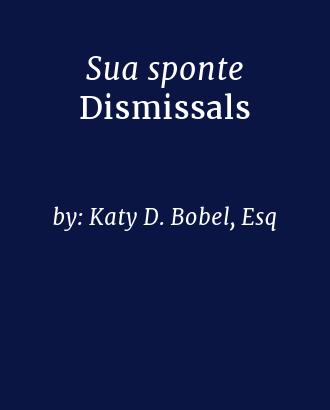By Katy D. Bobel, Esq.
Among the more powerful strategies in New York State litigation is to move for an accelerated judgment under Article 32 of the Civil Practice Laws and Rules.
A CPLR 3211 motion to dismiss allows a party to dismiss another party’s cause of action or defense before issue has been joined; while a motion for summary judgment pursuant to CPLR 3212 permits a judgment as a matter of law after joinder. CPLR 3216, meanwhile, allows dismissal of a party’s pleading for “want of prosecution.”
All of these applications for accelerated judgment require that a motion—or “application for an order”[1]—be made by the party seeking the relief in question. What is less known, however, is that a court also has the power to dismiss a cause of action, defense or pleading, sua sponte—i.e., by the court’s own motion.
“A court’s power to dismiss a complaint, sua sponte, is to be used sparingly and only when extraordinary circumstances exist to warrant dismissal.”[2] And a dismissal that does not satisfy the high standard may be reversed by the Appellate Division.[3]
Often times such a reversal by an appellate court is due to a complete lack of any advance notice whatsoever that the claim or affirmative defense in question could be dismissed. A sua sponte dismissal in Moran v. BAC Field Services Corporation,[4] for example, was reversed, because there was no motion before the Court seeking dismissal—and the Court itself had not put the plaintiff on notice that such relief could be granted by the Court on its own motion.
This begs the question: What “extraordinary circumstances” must exist to warrant a sua sponte dismissal?
Minimally, sua sponte dismissal is available where a litigant’s claim “flouts the integrity” of a prior order of the Court—and dismissal would not result in substantial prejudice to the litigant’s due process rights.[5]
In addition, such a dismissal is available when a party asserts claims that are completely inconsistent with the record before the Court; or seeks relief that has no basis in law.
A sua sponte dismissal of a contempt proceeding was upheld in Matter of Hersh,[6] for instance, where after nine years of litigation between family members—including a 29-day trial related to a separate discovery proceeding—the Court determined that the allegations forming the basis of the contempt application were undermined by the evidence presented at the trial. Likewise, in Roesch v. State,[7] a sua sponte dismissal of a psychiatric center resident’s special proceeding was affirmed. There the Appellate Division, Fourth Department found the resident’s Petition to be “wholly without merit inasmuch as [the] petitioner” was not in any way entitled to the relief he was seeking.[8]
Ultimately, the Court’s ability to act sua sponte (but with notice) allows a Court to control litigation—and protect the integrity of the judicial system—even when an opposing party fails to make a motion or otherwise act.
A recent case in Supreme Court, Schenectady County, provides an extreme example.[9] The pro se plaintiffs in the case had filed a pleading and a litany of other documents that were, as the Court characterized them, “replete with gratuitous, insulting and derogatory insinuations, as well as direct attacks on the parties, counsel, the legal profession in general and the New York State Supreme Court.”
Notably, the Court had warned the plaintiffs previously—both in writing and upon personal appearance—of the risks associated with their continued inappropriate conduct. The Court expressed particular displeasure that the plaintiffs had used offensive fictitious names for unknown defendants—including identifying one defendant with the name “Ima Lyn Hoe” and another as “Ibea Floutercheat.” The Court implored the plaintiffs to retain an attorney to represent their interests in a more appropriate manner.
In addition, prior to the sua sponte dismissal of the action in its entirety, several of the defendants had, in fact, filed motions to dismiss the plaintiffs’ Complaint. As a result, the plaintiffs were clearly on notice that dismissal was possible.
After thoroughly reviewing the extensive filings in the action, however, the Court declined to rule on the multiple motions to dismiss that were pending before it. Instead, the Court simply found that the plaintiffs’ filings were devoid of merit and motivated by spite or ill will—and that the plaintiffs’ conduct was “nothing short of reprehensible.” The Court invoked its sua sponte authority to dismiss the Complaint in its entirety against all defendants—even those that had not moved to dismiss.
The barrier to commence an action in New York is relatively low, regardless of the merits of the case. Inevitably, this results in some baseless and unjustified lawsuits being brought against unsuspecting and undeserving defendants.
The Uniform Rules allow a Court “upon …[its] own initiative, after a reasonable opportunity to be heard,” to impose costs and sanctions for frivolous conduct in civil litigation.[10] Caselaw makes clear that a court can also go further—and simply dismiss a party’s claim or defense in its entirety.
_____________________________________________
[1] See CPLR 2211.
[2] HSBC Bank USA, NA v. Oh, 225 A.D.3d 841, 842 (2d Dep’t 2024) (internal quotations omitted) (citations omitted]).
[3] See, e.g., Deutsche Bank National Trust Company v. Ellis, 225 A.D.3d 741 (2d Dep’t 2024); Anonymous v. Anonymous, 217 A.D.3d 619 (1st Dep’t 2023).
[4] 164 A.D.3d 494 (2d Dep’t 2018).
[5] Wehringer v. Brannigan, 232 A.D.2d 206, 207 (1st Dep’t 1996).
[6] 198 A.D.3d 776 (2d Dep’t 2021).
[7] 187 A.D.3d 1651 (4th Dep’t 2020),
[8] Id. at 1652 (internal quotations omitted).
[9] Swiencicky, et. al. v. Westcor Land Title Ins. Co., et. al., Sup. Ct. Schenectady Co., Index No. 2023-240.
[10] 12 N.Y.C.R.R. 13-1.1
